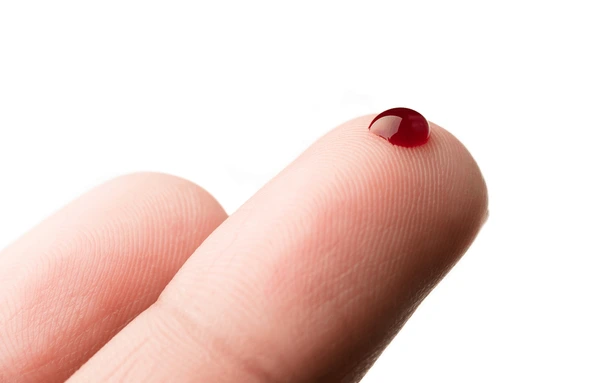
“immediately I felt the sting, my eyes squeezed tight. I opened them to see a bit of blood on my fingertip. In a flash, it was over, the nurse had fetched the blood and a cotton piece pressed to stop the tiny bleeding. At that moment I wished the cotton could also block the small tear trying to escape my eyes.
“For someone who feared needles (trypanophobia), I dreaded the monthly ritual of piercing my fingertip. Yet, monitoring my blood sugar levels was crucial. After repeating the procedure for months, I am almost needle tolerant,” shared Nana Gyan, a member of a family with a history of diabetes.
Nana, now 35, found himself facing a high likelihood of developing diabetes when he learned about his family health history a decade earlier. His father succumbed to a mild stroke, leaving a trail of health complications, including diabetes. His mother was already living with diabetes, carefully regulating her diet, tracking her blood sugar and taking her medications.
“The minute I learned about my inherited risk, I became vigilant. I opted for the routine discomfort of blood sugar checks over more intensive treatments. Adjusting my diet has been a struggle. I want to fully experience life, but whenever I talk with my mom and she mentions her health, it’s a reminder. A reminder that I owe it to my future self to keep my body as healthy as I can,” he admitted.
THE DISEASE
Diabetes is a chronic, metabolic disease characterised by elevated levels of blood glucose (or blood sugar). The World Health Organisation (WHO) says it is a major cause of blindness, kidney failure, heart attacks, stroke and lower limb amputation.
A resident doctor at the Korle Bu Teaching Hospital, Dr Kwekuma Yalley of the ‘Vodafone Healthline’ fame explains that globally, the disease burden is moving gradually from communicable disease, caused by infection, to non-communicable diseases with diabetes being one of the top four reasons people get sick or die.
Using a car scenario to explain diabetes, he said “our body is like a car, and food is its fuel. After we eat, the body turns food into a sugar called glucose for energy. The pancreas, an organ in our tummy, like a fuel regulator, releases insulin to help the glucose enter cells.
“In diabetes, either the pancreas doesn’t make enough insulin (Type 1) or the insulin doesn’t work properly (Type 2). Type 1 often starts young, while Type 2 usually happens later in life,” he said.
STATISTICS
Approximately 537 million adults aged 20-79 have diabetes (1 in 10 people) while it is predicted that this number will increase to 643 million in the next six years and further to 783 million by 2045, per International Diabetes Federation (IDF) data. More than three out of four adults with diabetes reside in low- and middle-income countries (LMICS) suggesting that the disease burden is higher in LMICS. In Ghana, WHO data shows that as at April 2023, 2.4 million people living with diabetes and approximately 7.5 per cent of adults have Type-2 Diabetes across the country,
“But this figure makes light of the severity of the disease in the country. When we look at specific areas, the Western Region has the highest rate of diabetes at 39.80 per cent, followed by the Ashanti Region at 25.20 per cent, and the Central Region at 24.60 per cent,” Dr Yalley said.
RISK FACTORS
In terms of risk factors, which he said, usually apply for type 2 diabetes included increasing age, overweight especially around the tummy area, lack of regular physical activity; lifestyle including smoking, consuming a diet high in processed foods and low in fruits and vegetables increases the risk.
He said patients who have other conditions such as having high blood pressure, women who developed gestational diabetes during pregnancy, individuals with a history of heart disease or stroke are at a higher risk likewise women diagnosed with Polycystic Ovarian Syndrome.
“Being of African descent like a Ghanaian is also a risk factor,” he explained.
Just like Nana Gyan, having close relatives with diabetes increases the risk. If both parents have diabetes, the risk for their child is significantly higher. The combination of genetic factors and shared lifestyle habits within a family can contribute to an increased susceptibility to diabetes.
SIGNS AND
SYMPTOMS
Early signs and symptoms of diabetes can vary, but they often include: feeling unusual thirst and hunger, frequent urinating, especially at night, unexplained weight loss, fatigue, slow wound healing, frequent infections, blurred vision, and numbness or tingling in the hands or feet.
Also, getting frequent infections, such as urinary tract infections, skin infections like boils, or gum infections may be a pointer. As the disease progresses, there may a blurred vision of feeling numbness or tinging in the hands or feet.
Diagnosis
To find out if someone has diabetes, Dr Yalley said, doctors use tests that check blood sugar levels like fasting plasma glucose (FPG) where you don’t eat overnight before the test; oral glucose tolerance test (OGTT), where you drink a sugary solution, and they check your blood sugar two hours later and the glycated hemoglobin (A1C), which shows the average blood sugar level over a few months.
“Indeed one may not even know how to interpret the results of these tests or they may be misinterpreted hence once you have any of the above symptoms it is advisable to seek medical attention early,” he said.
RISK REDUCTION
Since Type 2 diabetes is mostly lifestyle related, Dr Yalley said, Type 2 diabetes appropriate lifestyle modification may greatly reduce the risk or prevent further disease progression.
These include eating a well-balanced diet rich in fruits, vegetables, whole grains, lean proteins, and healthy fats. Limit the intake of processed foods, sugary snacks, and beverages.
He said moderation in food portions to avoid overeating; regular physical activity; at least 150 minutes of moderate-intensity aerobic exercise per week and maintaining a healthy weight through a combination of a balanced diet and regular exercise, had significant health benefits.
He cautioned against smoking and excessive alcohol consumption as the later could contribute to weight gain and impact blood sugar levels.
Dr Yalley said adequate hydration to supports overall health and well-being, schedule regular health check-ups to monitor blood sugar levels, blood pressure, and overall health were advisable.
Family history
Commenting on Gyan’s case, he said, being aware of one’s family’s health history, especially regarding diabetes could help assess risk and plan preventive measures accordingly.
TREATMENT
For treatment, Dr Yalley said it was dependent on the severity of the disease including lifestyle modifications as already discussed while for type 2 diabetes, oral medications may be prescribed to help regulate blood sugar levels. Individuals with type 1 diabetes always require insulin likewise some people with type 2 diabetes, particularly as the condition progresses.
Nutshell
According to Dr Yalley, lifestyle modifications play a crucial role in preventing the onset of type 2 diabetes or slowing its progression. He said regular monthly check-ups are recommended once issues with sugar control are identified.
“Failure to check blood sugar levels can lead to serious complications, including the risk of limb loss and impotence in men. Adhering to a healthy lifestyle and medical recommendation are essential for effective diabetes management and prevention of associated complications,” he said.
Nana Gyan says he is determined to live a healthier lifestyle.
“I cannot do anything about my parent’s medical history, but I can do something about mine even if it means bleeding once or twice every month to manage my blood sugar,” he said.
Note: Nana Gyan’s real name has been changed to grant him anonymity.
BY JONATHAN DONKOR



